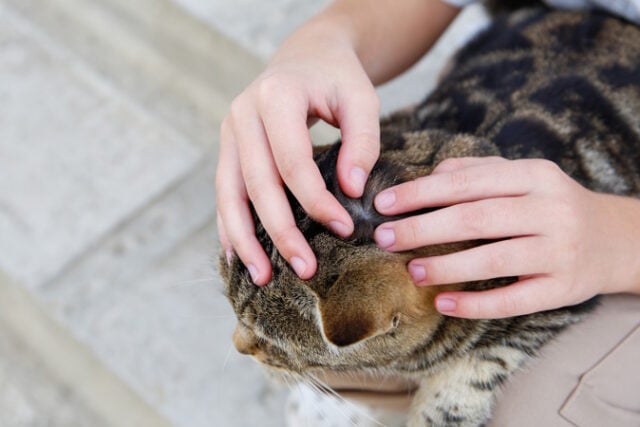
Last Friday in Jupiter I knelt beside a pool pump looking for ant trails when my client yanked a dark speck from her ponytail and whispered, “Tell me that isn’t a flea.” I’ve heard the same gasp from condo owners, Airbnb hosts, and even a groomer who feared her braid had become a buffet. The science—and years of crawl-space slogging—still says exhale. Fleas sip from us, but they don’t stick around.
Quick answer
Adult cat fleas (Ctenocephalides felis) will hop into human hair for a quick blood meal, yet our scalps run roughly 91 °F, almost ten degrees cooler than a cat’s skin. Lacking that heat―and the dense fur that lets eggs grip like Velcro―the flea abandons ship or starves within 24–48 hours. A January 2025 Trends in Parasitology review even shows the flea’s comb-like spines are specialized to slide through animal fur, not straight human strands.
When scratching turns to frustration, remember that help is only a click away: our local pest control service keeps West Palm Beach homes on a year-round flea-prevention schedule that starves the colony before it ever reaches your hair.
A flea’s true “dream condo” is still your terrier’s 101 °F hide-and-seek coat. Treat the pet and the scalp intruders vanish.
Why pets—not people—make five-star flea resorts
Fleas evolved beside warm-blooded, four-legged hosts. Their eggs hatch best when insulated by fur, and the adults’ saw-toothed mouthparts pierce thin pet skin more easily than the thicker epidermis on the back of your neck. One laboratory video I show new technicians slows the flea’s journey through a cat’s coat: it glides like a canoe downriver, combs locking around each hair shaft. Try the same stunt on a human strand and the “combs” jam, launching the insect back out into open air.
Palm Beach County: endless summer for fleas
 Palm Beach’s January nights rarely dip below 70 °F and humidity hovers near 80 percent, so flea season never truly stops. The National Pest Management Association’s Fall/Winter 2025 Bug Barometer® warns that milder-than-normal winter nights “could extend pest activity well into the new year” across Florida. pestworld.org Translation: expect scalp hitch-hikers at the holiday boat parade just as surely as during June’s soggy afternoons.
Palm Beach’s January nights rarely dip below 70 °F and humidity hovers near 80 percent, so flea season never truly stops. The National Pest Management Association’s Fall/Winter 2025 Bug Barometer® warns that milder-than-normal winter nights “could extend pest activity well into the new year” across Florida. pestworld.org Translation: expect scalp hitch-hikers at the holiday boat parade just as surely as during June’s soggy afternoons.
That constant pressure is why every year-round flea control plan starts in January, not May. Delay a month and pupae already hidden in carpets will emerge when spring humidity spikes.
Case study: from 200 bites to zero in ten days
Carrie M., a Wellington short-term-rental host, counted more than 200 red welts on her calves after tenants sneaked in an un-treated kitten. She shampooed daily, yet fleas kept hopping from throw rugs to her ankles—then into her hair while she cleaned. Our inspection found a living room rug registering 12 pupae per square foot. Treatment began with esafoxolaner topicals on the kitten, a growth-regulator mist for carpets, and daily vacuuming. By day 10, Carrie’s bite count was zero and the comb pulled nothing from her hair. She now books a West Palm Beach pest inspection every June and October to catch flare-ups early.
Health watch: murine typhus and other risks
Cat fleas can transmit Rickettsia typhi, the bacterium behind murine typhus. The CDC’s March 2025 advisory reminds clinicians that most U.S. cases cluster in warm, flea-dense states and often begin with an itchy flea bite that patients barely notice. Fever, headache, and a spotted rash may follow, so keep bites clean and seek medical care if symptoms appear. The good news is brief scalp contact makes transmission rare, but reducing fleas on pets short-circuits the pathogen’s entire journey.
How to tell a flea from lice or bed bugs
Fleas are reddish-brown, just 1–3 millimetres long, and flattened side-to-side like a pancake on edge. They spring when disturbed; lice crawl steadily and bed bugs lumber with a wider, walnut-shaped body. Flea “dirt” looks like pepper flakes that melt into reddish rust when dampened on a paper towel—a quick bathroom-sink test I run on-site.
You found a flea—now what?
First, shampoo as usual; the lather suffocates the stowaway. While hair is still wet, pull a fine-tooth nit comb from roots to ends, wiping the teeth on tissue to confirm capture. Strip bed linens and that straw sunhat you love, then machine-wash on a setting that reaches at least 122 °F. Vacuum every rug, sofa crevice, and car mat, emptying the canister outdoors. Finally, treat every furry resident the same day—one untreated cat can reseed the home in 72 hours.
Preventing the next jump (West Palm edition)
Weekly vacuuming matters because vibration coaxes pupae to hatch, and the machine removes them before they bite. Outdoors, keep grass clipped below four inches, clear palm frond litter, and redirect sprinklers so mulch stays dry; moist beds are flea nurseries. Raccoons and opossums strolling over rooflines drop fleas at gable vents, so secure trash lids and trim the fronds they use as aerial highways. Simple yard maintenance that cuts damp pockets and wildlife shortcuts keeps both fleas and mosquitoes in check.
When one flea means hundreds
If you’re plucking fleas from hair or socks daily, remember adults are only five percent of a colony. The other 95 percent hide as eggs, larvae, or cocoons deep in carpet nap. Our technicians layer insect growth regulators with low-odor botanicals—safe for rental guests yet lethal to every life stage—and schedule a follow-up check two weeks later to be sure the emergence cycle is broken.
FAQs (2025)
Can fleas live permanently in human hair?
No. Without dense fur and a 100 °F surface, they starve or leap off within two days.
How long can a flea survive on my head?
A few hours in most homes; at absolute best 24–48 hours indoors.
Do I need medicated shampoo?
Regular shampoo suffocates fleas; the comb clears bodies.
Will fleas give me murine typhus?
It’s very unlikely, but possible. Keep pets treated and bites clean.
Does shaving pets help?
Alone, no. Use vet-approved topicals or orals that kill before eggs are laid.
Fastest way to clear my house?
Treat every pet today, launder fabrics hot, vacuum daily for a week, and call a pro if fleas linger after 14 days.
Bottom line (2025)
A cat flea may hop onto your scalp for a sip, yet Florida’s warmth doesn’t grant it citizenship there. Treat the pet, tidy the home, and the stowaway dies or departs long before your next shampoo. Should scratching escalate or bites multiply, trusted pest specialists can step in, layering growth regulators with low-odor botanicals to completely neutralize every life stage, ultimately turning your house—and your hair—into a sustained, no-flea zone.
Disclaimer
The information contained in South Florida Reporter is for general information purposes only.
The South Florida Reporter assumes no responsibility for errors or omissions in the contents of the Service.
In no event shall the South Florida Reporter be liable for any special, direct, indirect, consequential, or incidental damages or any damages whatsoever, whether in an action of contract, negligence or other tort, arising out of or in connection with the use of the Service or the contents of the Service. The Company reserves the right to make additions, deletions, or modifications to the contents of the Service at any time without prior notice.
The Company does not warrant that the Service is free of viruses or other harmful components












